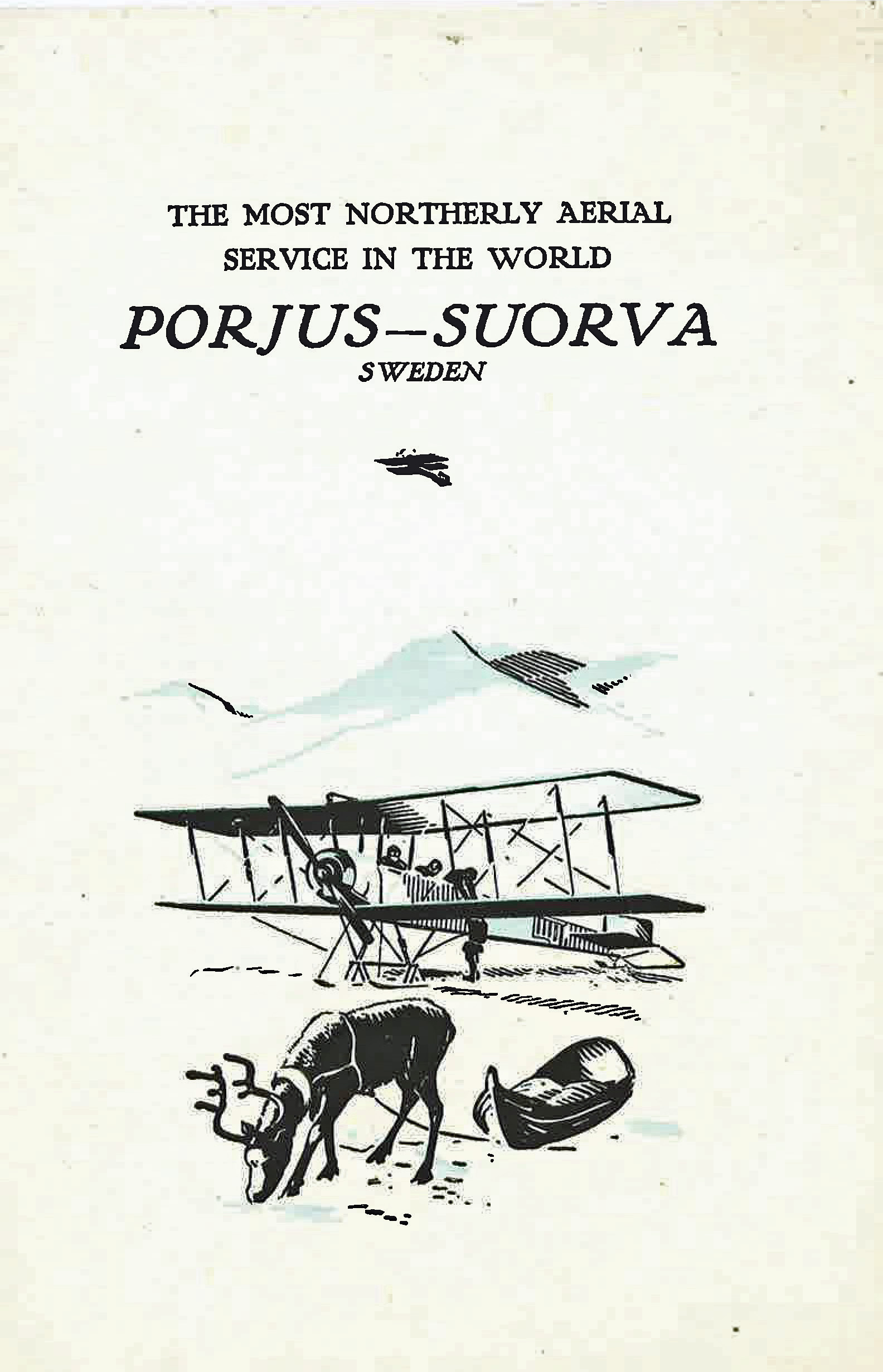 Far away in the extreme North of Europe and on the fringe of civilization a regular air service has been maintained for some years. The
Far away in the extreme North of Europe and on the fringe of civilization a regular air service has been maintained for some years. The
air route, right up within the Arctic Circle is probably quite unknown to the majority of people. The text here comes from a small leaflet
published in 1923 at the occasion of the International Aero Exhibition in Gothenburg. It has been adapted and photographs have been
added by Rob Mulder.
By: Royal Swedish Aero Club, Gothenburg and Rob Mulder
Printed: First printed in 1923 at the occasion of the International Aero Exhibition Gothenburg
Edited and text extended by Rob Mulder for European Airlines Rob Mulder
Owing to the exceptional difficulties, inseparable from its geographical situation, and to other necessary limitations, it cannot be claimed that the service maintained on this route has been of any great importance in the history of flying but it is precisely in these difficulties, encountered and successfully overcome that many will find an interest.
Therefore, we take a look at the operations of the most Northerly route in the world – at least in the beginning of the 1920-ies. We will give you a brief survey of the reasons for the service, the objects it served and the results it has achieved.
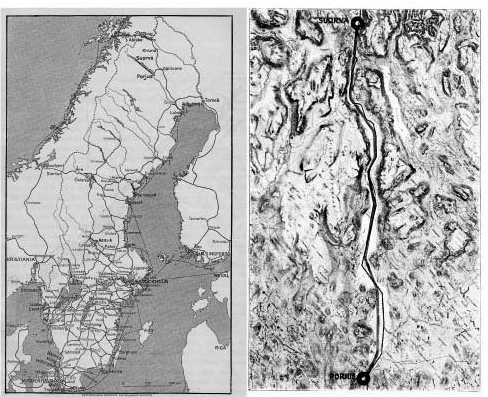
Map of Sweden with the air route drawn in.
On the Luleälf (River Lule) in North Sweden (long. 19° 42’E of Greenwich and lat. 66° 57′) some thirty miles within the Arctic circle lies Porjus Power Station.
Here has grown up a self-contained community with its Railway, Postal and Telegraph services. In order to supply Porjus and other important power stations on the Luleälf with adequate reserves of energy a series of lakes, formed by the Lule River, have been brought under control and utilized as reservoirs. In 1919 the construction of a dam was commenced at Suorvajaure (Suorva) , about 100 kilometers North West of Porjus. Before long this almost inaccessible mountain region saw the growth of a little working community of some three or four hundred souls. This community was practically shut off from the outside world. It could be reached in winter by horse drawn sleights and in summer by boat, the journey in either case taking two days to complete.
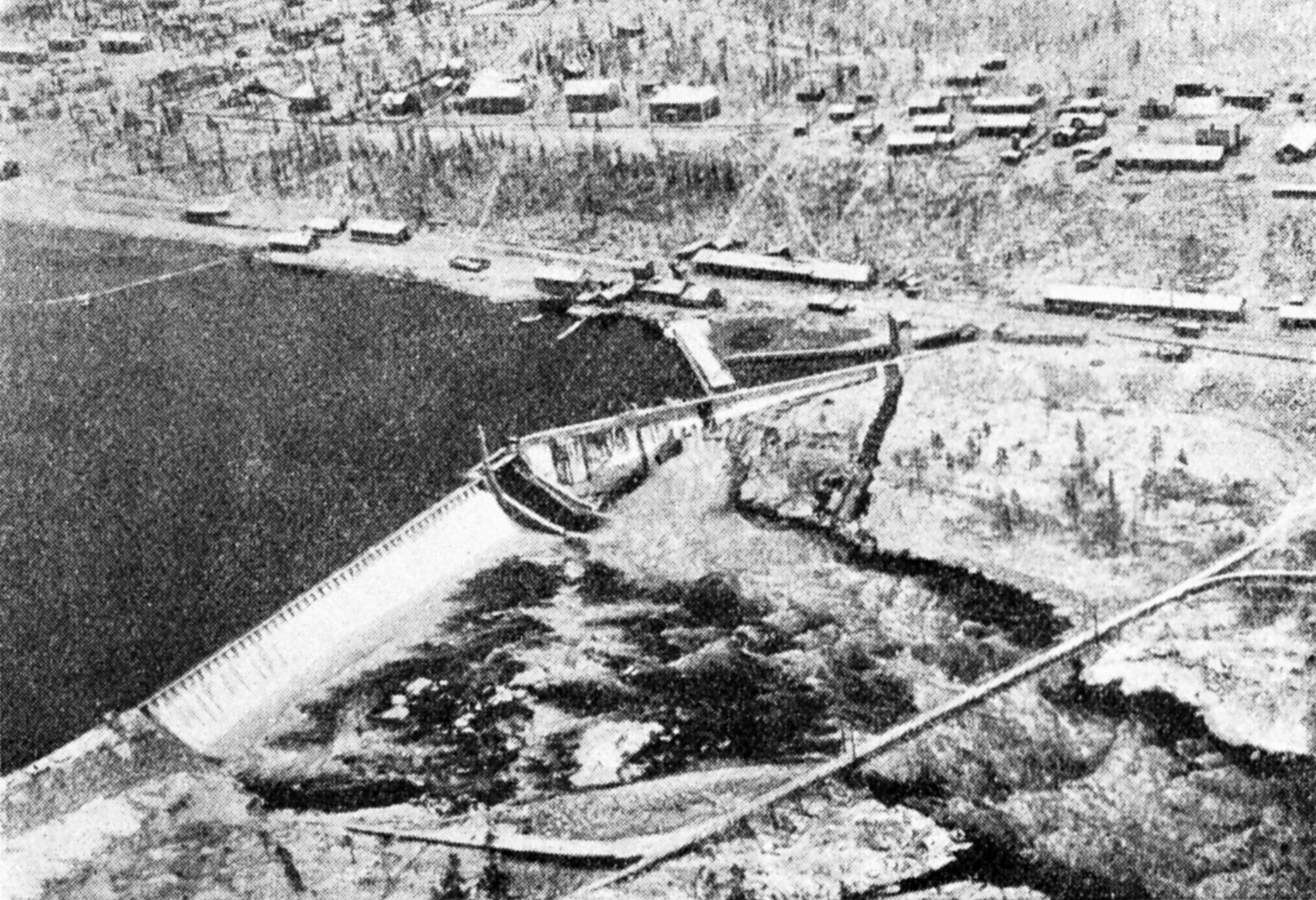
Village of Porjus.
To carry out so great a constructional work, in a limited space of time, with a force of from three to four hundred men isolated in the mountains was a task of some difficulty and the Kungliga Vattenfallsstyrelsen (KVS, Royal Waterfalls Commission) decided to inaugurate a regular service between Porjus and Suorva. By this means the time taken to complete the journey between these two places could be reduced to about one hour. The aeroplane could be employed for surveying, for the conveyance of doctors, for the carrying of sick or injured persons, often a very necessary function, and also for the transport, in case of need, of medicines, food, mails and spare parts of machinery. Experimental flights began at the end of August 1920, the aircraft employed being an English Fairey IIIC (ex G-EAPV) with 360 hp Rolls Royce engine.
The experiment proving successful the Waterfalls Commission decided to purchase the necessary aircraft to enable it to maintain a regular service.
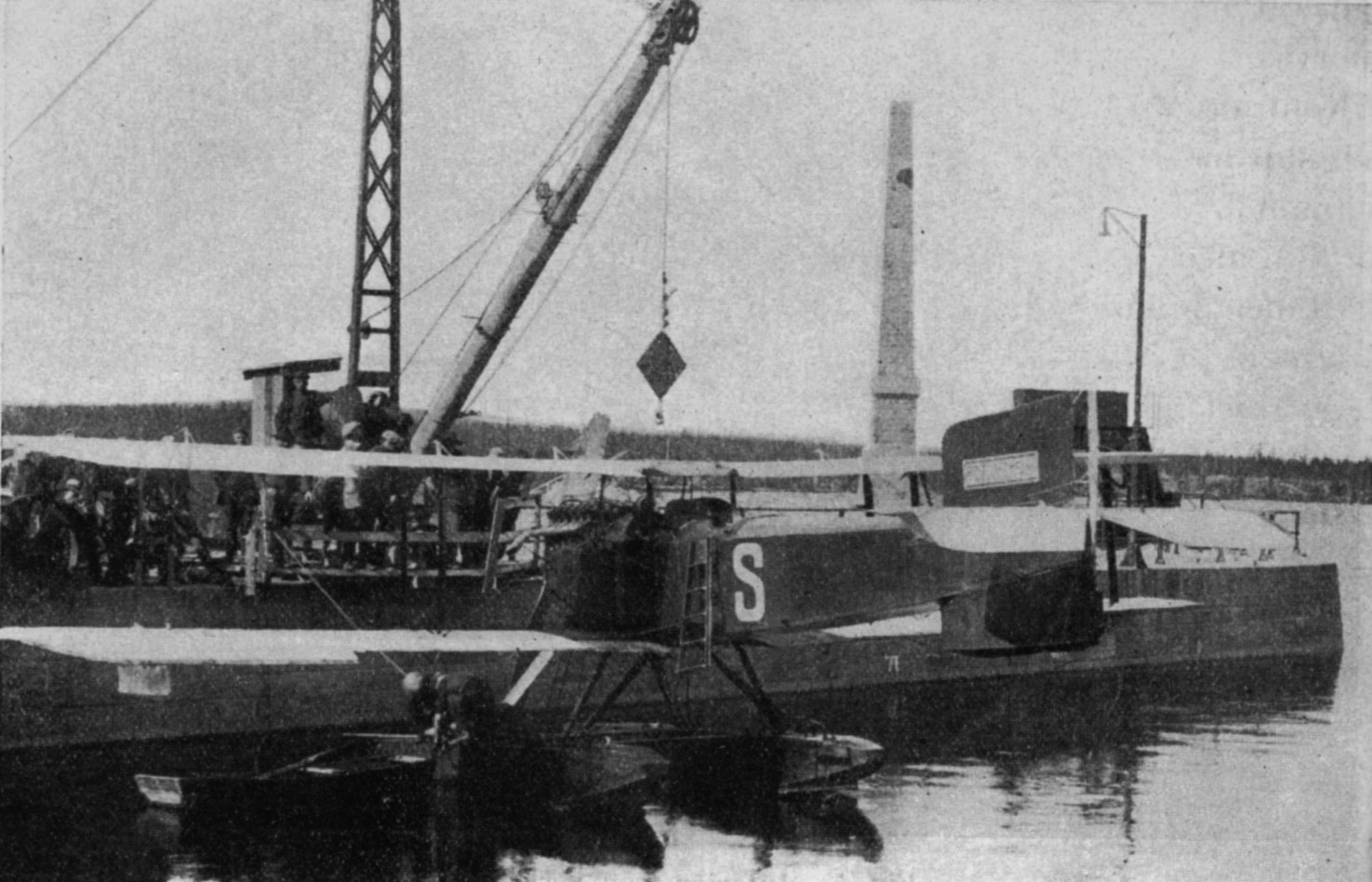
The Fairey IIIC (ex G-EAPV) in Sweden during the Autumn of 1920.
A hangar and slip were built at Porjus during the autumn of 1920 and, simultaneously, a slip at Suorva. During the experimental service with the Fairey aircraft it was found that, owing to the mountainous nature of the country, the air was usually liable to disturbance so that flying with a heavy type of aircraft was positively dangerous. A comparatively small aircraft of exceptionally light weight, having the ease of control of a chaser combined with great stability was what was required. Further, in order to avoid unnecessary expense, the aircraft had to be adaptable for use as a seaplane during the summer and capable of being fitted with skids for employment during the winter. It was also desirable that, in view of the extreme cold experienced during the winter months, frequently as much as 35° to 40° Celsius, the engine should be air and not water-cooled.
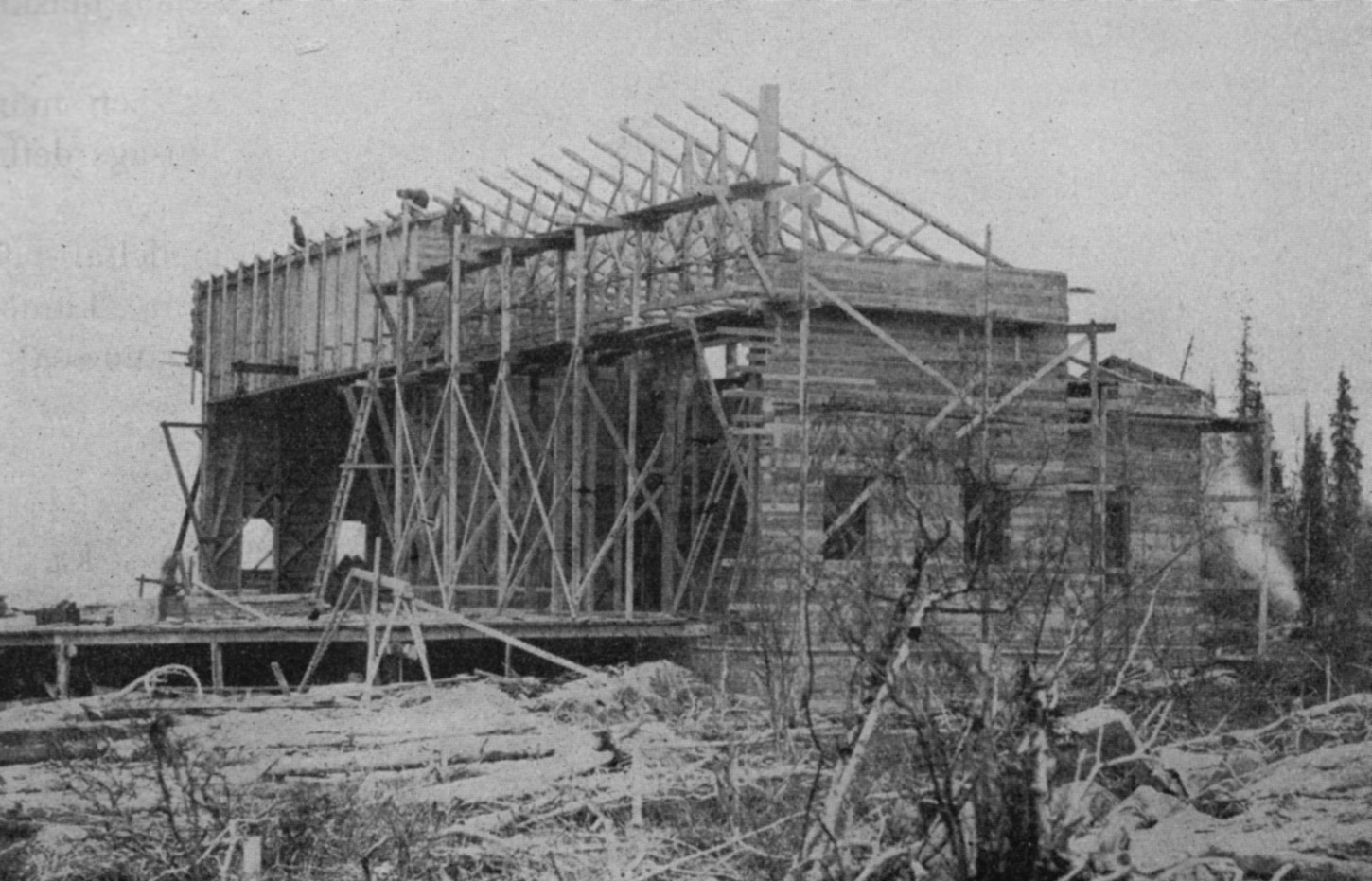
Hangar under Construction, Winter 1920-21
All these considerations led to the purchase of an Avro aircraft, type 504 K, with a 130 hp Clerget motor. Although this aircraft can hardly be classified as a modern passenger and freight carrying aircraft yet it has shown itself to be almost ideally suited for service under the especially severe climatic conditions which it had to encounter.
The route followed after leaving Porjus the length of the Porjuselet (8 km) and the Luleluspe rapids (3 km) after which the Lulejaure Lake (45 km) was traversed. Next came the Jaurekaska rapids (2 km) and the Lake Langas (35 km). At Saltoloukta, the Lake Jaurekaska became very narrow and made a sharp S-turn. Here was one is right up in the midst of the Arctic wilds, practically all vegetation disappears and only rocky precipices were to be seen rising perpendicularly some 800 meters from the waters of the lake. At the Northern extremity of Lake Langas were the Stora Sjöfallet or Great Lake Falls after which the course of flight followed the length of the Lake Kårtejaure (10 km) at the Northern end of which is situated the little community of Sourva. The flight which was altogether some 100 km had followed a course which is nearly due North West from the point of ascent.
It has previously been indicated that, as the following will show, atmospheric conditions were particularly liable to disturbance. At Saltoloukta the mountains, which are here nearly 1,000 meters high, formed a funnel-shaped opening the orifice having an S-shaped turn. As the air rushes out through this passage it was obvious that very curious air current could be occasioned. Small, well defined cyclones, which had the effect of drawing up snow or water into columns twenty meters high, were frequently observed. On one occasion, whilst flying over Jaurekaska, as many as ten such cyclones were observed at one time.
Wind and weather conditions were, as a rule, very changeful and this applied especially to Suorva where the velocity of the wind has been known to increase in less than an hour from ten meters per second South east to twenty meters per second North West. It can be added that, owing to the height of the surrounding mountains, the winds at Suorva blow only from these two quarters. Porjus and Suorva were connected by wireless telegraph so that a pilot leaving Porjus could ascertain the state of the weather at the other end and, as the wireless station is also a meteorological station, he can learn the weather prospects some hours ahead. This wireless communication had been of greatest possible service in connection with these flights.
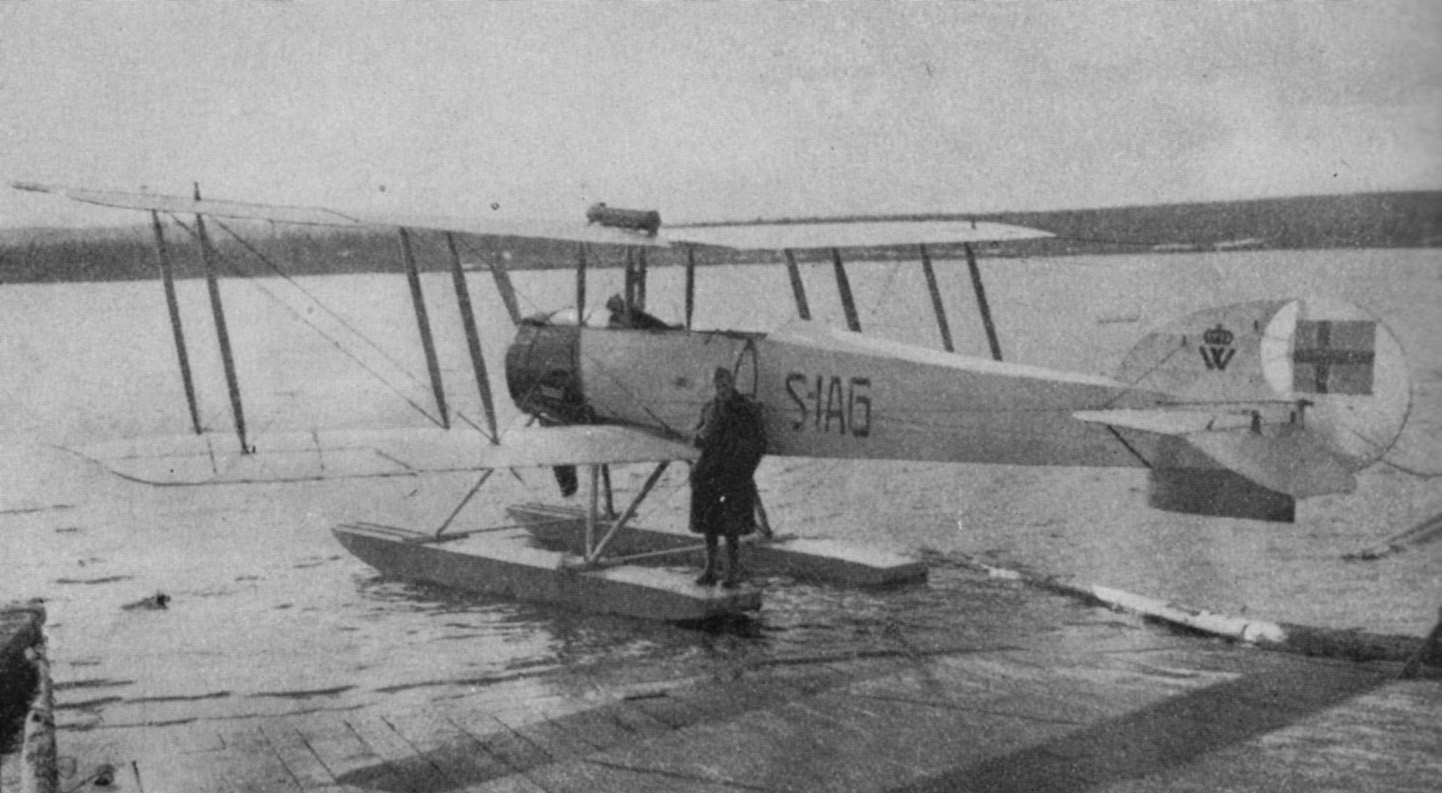
Avro 504KL, S-IAG Nr.3 on floats.
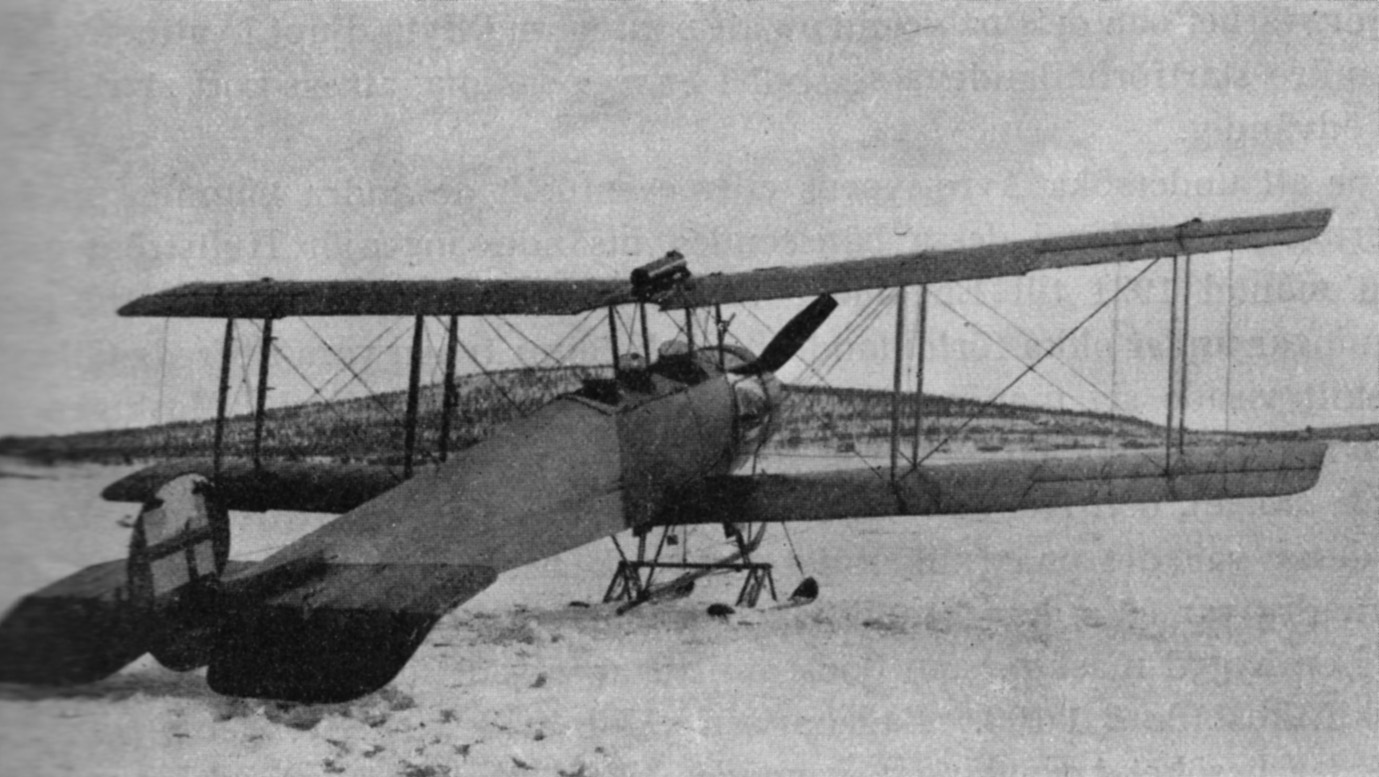
Avro 504KL, S-IAG, Nr. 3 on skis operating the service Porjus – Suorva.
Regular aerial service from Porjus to Suorva and vice-versa occurred three times weekly and since the start in 1922 the Royal Mails have been conveyed in this way. It has however been found necessary to make extra journeys from time to time and the average number of return journeys per month have been from 20 to 25.
From the beginning of 1921 until October 21, 1923, 524 separate flights were made between Porjus and Suorva. The number of passengers conveyed during this period was 816 and 13,049 kilograms of freight was also carried and, if the weight of mail transported since the commencement of 1922 be added, the total amounted to 14,226 kilograms.
Of the 106 journeys with mails which had been undertaken since the beginning of 1923, 87 have been completed within schedule time, an average of 82 %, and the failures were in nearly every instance caused by snow storms which rendered flying impossible. During the winter months daylight lasts for three or four hours only and this circumstance was obviously a considerable disadvantage. On the other hand extreme cold had rarely interfered with traffic and it had been found possible to fly with the thermometer at minus 40° Celcius.
As an illustration of the difficulties occasioned by the climatic conditions it was of interest to note that Suorva, lying nearer the Norwegian coast than Porjus, was much more subject to the influence of the Gulf Stream and had a considerably higher temperature. The sphere of this influence was often very distinctly efined and, as a rule, was to be found at Saltoloukta and it sometimes happened that an aircraft leaving Suorva had commenced its flight in mild weather with a damp atmosphere, but had suddenly entered a very cold region so that its wings had become so heavily encrusted with ice that flight had been rendered impossible and the aircraft had to come to ground. In fact, all delays in the mail service had been directly attributable to severe weather conditions. During the summer, when climate conditions were more favorable, a very high degree of regularity had been obtained.
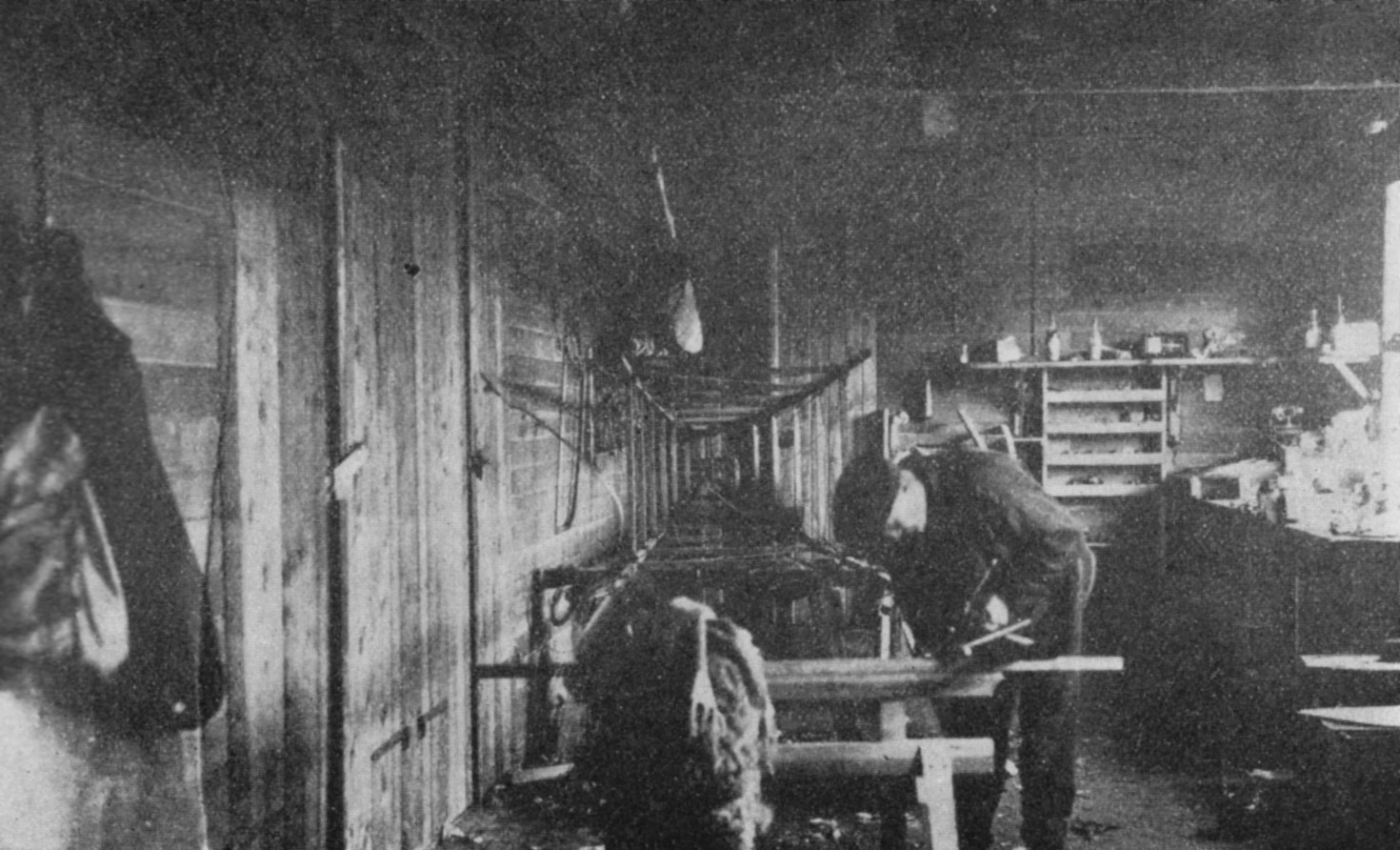
Inside the workshop of the hangar at Porjus.
On the whole it can be claimed that the flights have achieved their purpose and, even though meteorological conditions have from time to time necessitated the postponement of a flight, yet the aircraft has never failed to reach its objective before the usual horse drawn conveyance or the steamer could possibly hope to deliver the mails.
On many occasions of sickness or accident the aerial service has been of the greatest possible utility in conveying the sufferer with the upmost speed to a doctor and although under such circumstances it is not possible to be too particular regarding the state of the weather, never once had the aircraft failed in its errand of mercy. Urgent cases of illness had at times required the transport of a patient to Porjus in the middle of the night.
The maintenance of a regular service had a marked psychological effect upon the inhabitants of this isolated spot. The knowledge that, in case of need, they and their dependents can be carried at short notice and with the utmost rapidity down to populated districts has had a markedly beneficial influence and induced a feeling of safety and equanimity.
Up to 1923 there had been an entire absence of serious accidents on this route and this circumstance served to inspire the people in these parts with confidence in this new method of transport. The service which was under the general supervision of the superintendent having charge of the constructional work at Luleälvens Power Stations, was managed by Mr. G. Hulström. The regular pilot was Mr. A. R. Holmén, who had two mechanics and a joiner at his disposal, though in case of need Hulström took the helm.
Details about the operation
As mention, the Kungliga Vattenfallsstyrelsen was a board responsible for the regulation of rivers, waterfalls and such and had in 1919 made a start with the regulation of the river Lule in the north of Sweden. For a swift transportation of the 400 men personal, the mail, medicaments and spare-parts over the 110 km long River Lule, the KVS suggested the use of the new mean of transportation: the aeroplane. The terrain along the river was quite inaccessible and a trip from Porjus to Suorva could well take several days. In November 1919, the KVS requested for an additional subsidy for the exploitation of the air service. The two main airline companies in Sweden, the Svenska Lufttrafikk AB (SLA) and the P.O. Flygkompani were ask to bid for the tender and after careful consideration the KVS awarded P.O. Flygkompani the concession.
Once P.O. Flygkompani was awarded the concession, the English pilot G. L. P. Henderson started with the Fairey IIIC on August 19, 1920 (other sources claim the August 15) the world’s most northern air service from Porjus to Suorva. Without any irregularities, the floatplane made up to October 25 numerous flights. These flights were suspended until the lakes had turned into ice. In Porjus a landing strip and a hangar were constructed. The hangar could house two aircraft and included a workshop. In Suorva the landings took place on the lake, where the waves caused problems. The use of the start- and landing strip on the Lake Porjussel at Porjus was could be a risky one. Due to unfavourable winds the aircraft had to take-off directly towards the entrance of the hangar. A wireless service was established on both places and during 1921 more than 7,000 telegrams were wired.
Once the Fairey IIIC had suspended its flights on October 25, it was taken on shore and underwent a major overhaul. In addition the aircraft had its wheel undercarriage replaced by a ski undercarriage and a cover closed the rear cockpit. Now five passengers or 1,800 kg of cargo could be taken along in more comfortable conditions. Trial flights made in the beginning of December proved that the aircraft now was far too heavy and even went through the ice on one of the flights. By the end of December 1920 P O Flygkompani could not meet its obligations and from January 1, 1921 the KVS took over the service.
KVS bought the Fairey IIIC for SKr.29,717.95 from P O Flygkompani and modified the aircraft even further. But by the end of January the aircraft had to be taken out of use, because the water-cooled engine froze at -15° Celsius and the aircraft was still too heavy to land on thinner ice. At the end of February 1921, an AVRO 504K was acquired and delivered. Although having a lower payload, the AVRO 504K had splendid start- and landing abilities and was easier to manoeuvre. It carried beside the pilot, two passengers. This aeroplane, together with two others that followed, was modified with a cover over the rear cockpit to protect the passengers from the hazardous weather conditions. Former SLA-employee Ing. G Hulström was hired as Chief of the Flying-Service and also former SLA-pilot Rolf Holmén joined the KVS. In addition two engineers and a carpenter were hired.
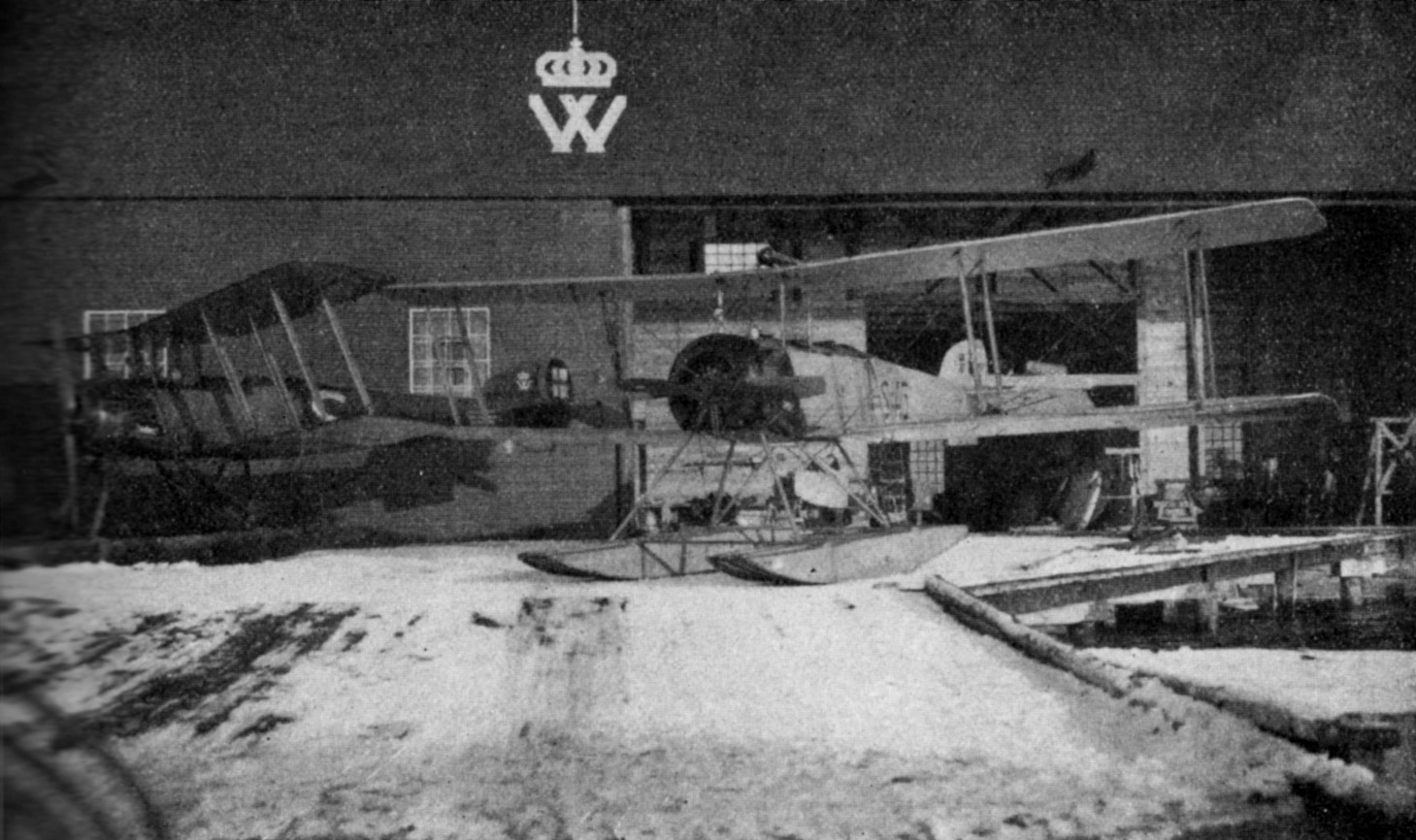
The Avro 504KL, S-IAA Nr 2 Svalan (left) and S-IAG Nr.3 (right) on floats ready for the summer service.
After a series of successful trial flights in March, KVS resumed the air service in April. The frequency was three times weekly, with the possibility for additional flights on demand. The three AVRO 504Ks made 30% more flights than in 1920 and by September 270 flights were made, carrying 327 passengers and 5,951 kg freight. During the year, KVS also started to transport the wages of the workers by air. The KVS was very pleased about the AVRO 504K and mentioned in its annual report ‘’…One of the aircraft for example took off from Lake Kårtjejaure (situated at 400 metres above sea level) filled with fuel and carrying three passengers’’.
As from January 16, 1922, KVS took along the mail on this service and also regular passengers were taken along now. These passengers paid 300 Kronor for a single and 500 Kronor for a round-trip. A short joy ride flight could also be made.
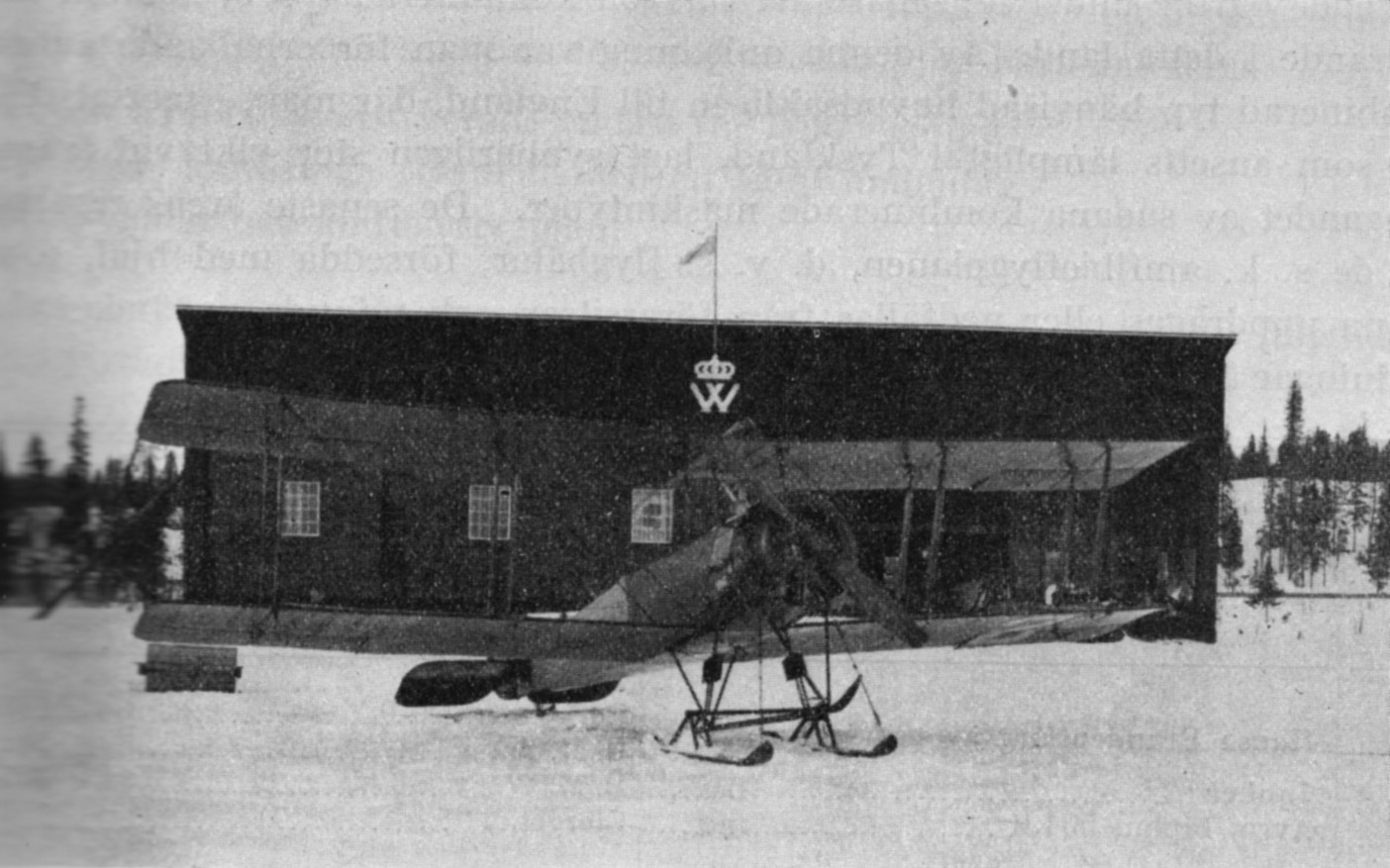
Avro 504 KL, S-IAB, Nr.1 “Svalan” in front of the hangar on skis.
During the summer months the aircraft were equipped with floats and during the winter with skis. Christmas 1922 the AVRO 504K, S-IAG had to be written off. The pilot Gösta Hulström suffered during take-off a blow out of the engine and after the subsequent extra-ordinary landing the aircraft was blown over by the strong winds. It hit the ice and was destroyed beyond repair. The two passengers (K. R. Börg and Ing. Hennel) only suffered minor injuries.
In May 1923, the project was finished and the service was permanently suspended. The results for the period January 1922 – May 1923 were: 595 flights, 425 passengers, 1,571 kg airmail and 18,897 kg freight. The aircraft flew some 71,000 km and were 635 hours and 29 minutes in the air. Regularity reached 82%. The costs for the air service mounted in the first year (1920) SKr.87,844.70, for 1921 SKr.121,415, 1922 SKr.7,937 and in 1923 SKr.10,733. KVS had paid SKr.71,312.23 for the three AVRO 504-aircraft and the remaining two aircraft were sold to AB Göteborgs Luftdroskor, which also took over the pilots Hulström and Holmén. The Fairey IIIC was by then dismantled and the engine sold to the Swedish Navy.
KVS was after the discontinuation of the service very satisfied with the achieved results that high north of Europe. It had close to none technical problems and the aircraft manufacturer A V Roe and Co. Ltd. in Newton Heath, Manchester in the United Kingdom could be proud of its aircraft.
| Aircraft operated by the Kungliga Vattenfallsstyrelsen (KVS) | |||||
| Type | PI | c/n | Swedish Reg. | In (I) or Reg.(R) | Fate |
| Fairley IIIC | G-EAPV | F.302 | – | I Aug 1920 | Not registered |
| Avro 504KL | G-EANB | ATC.18 (5017) | S-IAA | R 1 Oct 1921 | Nr. 3 “Måsen”, 1 Dec 1922 to S-ABAA |
| Avro 504KL | H1911 (RAF) | S-IAB | R 1 Oct 1921 | Nr. 1 “Svalan”, 1 Dec 1922 to S-AAAA | |
| Avro 504KL | H1912 (RAF) | 5025 | S-IAG | R 1 Oct 1921 | Nr. 3, 18 Dec 1922 dbr during snow storm at Saltoloukta, wfu |
